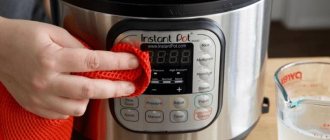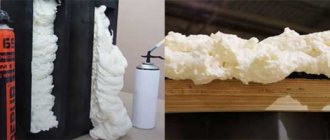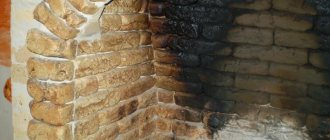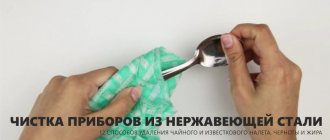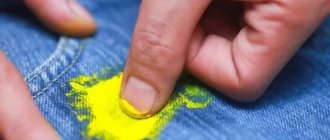Unlike cooking on a conventional stove, gas or electric, the process of heat treatment of food in a multicooker, thanks to the hermetically sealed lid of the household appliance, allows you to keep the kitchen surfaces surrounding the appliance - the hood, tables, cabinets - clean.
However, during operation, the structural elements of the multicooker itself become dirty, which can lead to a decrease in the performance of the device or its breakdown.
Proper preparation of the multicooker before washing
Before cleaning the multicooker:
- Unplug the device from the outlet.
- If you were cooking something, wait until the heating disc cools down.
- If the cover is removable, detach it from the “base”. If the cover is not removed, the heating component is protected from water and cleaning agents. It is enough to wrap the bowl in several layers of dense polyethylene.
- Next, remove other removable parts - bowls, valves and moisture collectors.
Prepare equipment cleaning products:
- sponges;
- soft cloth for wet cleaning;
- microfiber cloth for dry cleaning;
- dishwashing detergents;
- improvised home remedies - household. soap, vinegar, lemon juice, baking soda;
- rubber gloves to protect hands.
If you just bought an item, be sure to wash it thoroughly - the equipment must be cleaned of all factory contaminants and freed from the smell of plastic.
Before cleaning your multicooker, consider these tips:
- To avoid damaging the equipment, do not place a wet bowl in the device - wait until the container is completely dry.
- The most delicate cleaning of the device is with microfiber cloths.
- Do not wash the sealing rubber with hot water - this will destroy its tightness.
- If the device emits a persistent smell of rancid food, add 2 tbsp to the cleaning solution. spoons of lemon juice.
- If food continues to burn even after washing the bowl, then the non-stick layer is damaged and the container needs to be replaced.
My bottom
During the cooking process, food particles or drops of fat often get into the space between the bowl and the bottom of the multicooker.
Therefore, after washing the bowl, do not rush to put it back in place: carefully inspect the bottom of the device and, if necessary, clean it of crumbs and grease stains with a pre-moistened soft cloth.
In case of significant contamination, soak a sponge in water, then in baking soda and very carefully clean the bottom of the household appliance.
ADVICE! After removing the fat, rinse the bottom and walls with clean water and wipe them dry with a towel.
How to clean the multicooker bowl?
The difficulty of washing multicookers is that the device cannot be cleaned as a whole - all removable components are washed separately. We'll start with the bowl - depending on what material it's made of, cleaning varies.
Ceramic bowl
Remember that this is a fairly fragile item that needs special care:
- Protect the container from hitting the walls of the sink or dishwasher basket. It is best to wash ceramics by hand.
- Avoid abrasive scourers, caustic agents, and acids.
- Do not use soda (both baking soda and baking soda) and various cleaning powders for washing.
- If there are often burnt food residues, do not remove them using iron sponges, scrapers and brushes. This will damage the non-stick coating.
- The best substance for washing is liquid, helium, with abundant foam formation. In principle, any dishwashing liquid fits this description. There are also special gels specifically for ceramics.
- Remember that non-stick shells are sensitive to sudden changes in temperature - wash the bowl only when it has completely cooled.
Teflon bowl
Teflon is a less capricious material when compared to ceramics, but it also has its own care rules:
- Do not use powder mixtures, abrasive scourers or metal scrapers. They stop unnoticeable scratches on the surface, which over time deepen to large cracks in the body.
- Give preference to delicate gel cleaners that do not contain acids.
Most Teflon containers clean well in the dishwasher. But still, before cleaning, it is better to make sure by reading the instructions for the device.
If you need to clean the multicooker from carbon deposits:
- Fill the bowl with water and leave to soak for 1 hour.
- Using a wooden spatula, carefully remove the carbon deposits.
- Does not help? Add 1 tbsp. spoon of soda, pour 500 ml of water. You can dilute the juice of ½ lemon in 1 glass of water.
- Place the container back into the multicooker.
- Turn on the device, switch to the “Baking” mode, but do not close the lid.
- When the liquid boils, wait another 10 minutes and turn off the equipment.
- After 30 minutes, try again to remove the carbon deposits with spatulas.
- Wash with dish gel, wipe dry outside and inside.
Cleaning rules depending on the type of coating
Ceramics
The bowl, the inside of which is coated with a ceramic non-stick layer, requires very careful handling , since any careless movement or incorrectly selected cleaning agent can lead to the formation of cracks and chips on the surface.
It is unacceptable to use hard sponges and brushes to wash the ceramic coating.
Regarding the choice of cleaning products, only those preparations that do not contain abrasive particles and have a chemically neutral composition are suitable for removing grease from a ceramic surface.
Do not wash this type of bowl with alkaline agents and soda.
The ceramic container can only be cleaned by hand - do not use a dishwasher to remove dirt.
REFERENCE! After purchasing a multicooker, before using the device for the first time, wash the bowl with warm soapy water, rinse the reservoir, lubricate its walls with a small amount of vegetable oil and warm up the device (40-60 seconds) - this simple technique will improve the non-stick properties of the ceramic coating.
Teflon
Teflon, like ceramics, has a capricious “character” : small scratches on the coating turn into chips in a very short time, as a result of which food begins to burn in the multicooker and the bowl becomes unusable.
Soft sponges and neutral detergents are suitable for cleaning Teflon coating.
In some cases, it is permissible to wash the container in the dishwasher (information about the possibility of using this method should be indicated in the instructions for the multicooker).
IMPORTANT! Teflon does not “like” sudden temperature changes, so if you have recently prepared any dish in a multicooker, start cleaning the bowl only after it has completely cooled.
How to properly clean the multicooker body?
How to clean the multicooker body? No matter what type of multicooker you have, it cannot be washed under running water from the tap.
Cleaning outside
When you actively use the device, you will notice that its outer side also becomes dirty and covered with traces of grease.
The easiest way to clean a multicooker from fat is to use the following recommendations:
- Use gels and sprays to clean household appliances.
- If the surface is plastic, do not use abrasive powders.
- The metal body can be thoroughly washed off old dirt with regular baking soda.
- To make your multicooker literally shine, apply a little glass and mirror cleaner to a piece of rag. Rub it onto external surfaces that do not come into contact with food.
How to clean the inside of the multicooker body?
For convenience, housewives combine cleaning of the housing and the heater.
Here's how to clean the inside of your multicooker:
- Disconnect equipment from the network.
- Remove removable components.
- Make foamy water by diluting a little dish gel in water.
- Dip a cloth in the solution and wring it out well.
- Gently wash all internal parts with a damp cloth - bottom, sides, tank.
- Use a soft dry cloth to wipe all surfaces dry.
- Leave the device open for a while to allow the water to evaporate.
Do I need to wash the multicooker after purchase?
You shouldn’t immediately after purchasing, put food into the bowl and start cooking. It is likely that during production and sale the device was exposed to various influences, so before use, it is better to wash all parts that will touch the products. Wipe the outer and inner parts of the body with a damp cloth, and the bowl and lid with a soapy water solution.
Before first use, pour a glass of water into the bowl and turn on the “steam” mode for 10 minutes. The procedure will help get rid of residual substances applied during final processing of the product at the factory.
Proper cleaning of the multicooker lid
Let's figure out how to wash the multicooker lid. Depending on whether it is removable or not, there are two instructions.
Removable cover
The simplest procedure: first you clean with a washcloth or napkin with dish gel, and then rinse off the detergent under running water. If the manufacturer does not prohibit it, a heavily soiled lid can be soaked in soapy water before cleaning.
Fixed cover
To properly clean such a cover, you first need to protect the heater disk from moisture. Since it is located at the bottom, take thick polyethylene or cling film and line the bottom with it, making allowances for the walls.
Here's how to clean a multicooker at home:
- Tilt the device over the table so that the lid lowers to a horizontal position.
- Periodically dip the washcloth in the foamy dishwashing gel solution.
- Pay special attention to the most contaminated places - the sealing rubber and the hole for the steam valve.
If the non-removable lid is very dirty and cannot be washed, proceed as follows:
- Reinstall the bowl (if it was removed).
- Add 1 tbsp to the container. a spoonful of lemon extract (can be replaced with 2 pieces of fresh citrus) and 1 glass of water.
- Switch the device to “Steam” mode and leave for 20-30 minutes.
- Allow the equipment to cool, remove the bowl, and unplug it from the outlet.
- To clean the multicooker from grease, repeat cleaning with a sponge and soapy water - the grease deposit has already softened, it will be easier to remove.
Chemicals
The range of household chemicals includes products specially designed for cleaning multicookers. Their composition copes well with grease and food residues and does not harm the surface. Effectively removes grease and dirt from ceramic or Teflon surfaces. Eliminates odors and has antibacterial protective properties. Sometimes the detergent kit includes a special sponge for cleaning non-stick surfaces.
This product can be replaced with gel or foam for kitchen appliances, as well as dishwashing liquid with a neutral pH level.
Cleaning the bottom and heating disc of the multicooker
The heating device must be protected from liquids and food particles.
If food still gets on the disc, here's how to clean the inside of the multicooker:
- Dilute 1 tbsp. a spoonful of baking soda in 1 glass of water until the powder is completely dissolved. You can make a solution by stirring a small amount of dish gel in water until a rich foam forms.
- Take a soft washcloth, dip it in the prepared solution, and squeeze thoroughly.
- Clean the heating component from dirt with a sponge.
- After cleaning, wipe the element dry with a soft cloth.
- It is recommended to keep the device open for some time to allow all the liquid to evaporate.
If there are only dried crumbs inside the device, you can carefully sweep them out with a damp cloth and then wipe dry with an absorbent cloth.
A heating element
The heating element of a kitchen appliance must always be kept perfectly clean. If grease, crumbs or other contaminants get on its surface, do the following:
- Disconnect the multicooker from the power supply and let it cool completely;
- remove the device bowl;
- Use a soft foam sponge to remove large debris from the heating part.
REFERENCE! If there is plaque left on the element, lightly moisten the sponge in water, dip it in soda and very carefully wipe the surface of the part, then remove the remaining product with a damp cloth, dry the treated surface with a towel.
How to clean the steam valve in a multicooker?
Do not forget to monitor the condition of this element: if it is clogged with food debris, it will not be able to properly pass moisture through itself, which means that the cooking technology will be disrupted.
When you run your slow cooker constantly, make it a habit to clean the valve every week. If during cooking the dish has risen to the lid, it is best to clean the part immediately after using the unit.
Cleaning is the simplest: rinse the element under running water. If there is old dirt on the valve, soak it in foamy liquid, and then rub it well to remove grease deposits with the hard side of a dishwasher.
Moisture collector
Absolutely all models of kitchen appliances are equipped with a moisture collector - a special container designed to collect condensation that forms on the lid during cooking.
After each use of the multicooker, the moisture collector should be emptied of accumulated moisture and washed with running water and detergent.
If liquid is not removed from the reservoir in time, mold may develop in the device . Be sure to dry the moisture collector before installing it in place.
Folk remedies for cleaning multicookers
To make your multicooker look like new, you don’t need to buy expensive imported substances. You can get by with proven and effective folk remedies to get rid of the smell in the multicooker.
Soda
First, make sure that the surface can be cleaned with powder and abrasive products.
To thoroughly clean the body and the outside of the lid, you need:
- Mix 2 tbsp. spoons of baking soda with 50 ml of water - you will get a homogeneous “puree”.
- Apply a little product to a sponge and wipe the dirty areas with it.
- Leave the soda slurry on the surface for a while.
- Remove the product containing wet grease with a damp cloth.
- Wipe dry with paper or cloth napkins.
Vinegar
Ordinary table vinegar not only removes unpleasant odors, but also perfectly eats away fat.
The simplest “recipe” for cleaning a multicooker:
- For 1 liter of water - 1 tbsp. spoon of vinegar. To prevent it from emitting an unpleasant odor, take not a table odor, but an apple one.
- Soak a soft cloth in the solution and wring it out.
- Wipe the body, lid, and tanks inside and out with a cloth.
- Wipe dry with a soft microfiber.
If the contamination is persistent, try setting up a steam vinegar bath - a great way to clean the inside of the multicooker:
- Take a heat-resistant container, pour 1 glass of water, 1 tbsp. a spoonful of food vinegar.
- Place this bowl at the bottom of the steamer bowl and close the lid of the device.
- Activate “Steam cooking” for half an hour.
- Wait until the device cools down.
- All you have to do is wipe the contaminated surfaces with a sponge to remove softened fatty deposits.
Lemon acid
A remedy for grease and unpleasant odor.
See how to remove odor from a multicooker:
- Cut the lemon into several small pieces.
- Pour into the multicooker bowl, add 1 liter of water.
- Close the lid and activate the steam mode for half an hour.
- Wait until the device cools down.
- Wipe the bowl and interior surfaces of the multicooker with a microfiber cloth.
Tools for working at home
To clean the multicooker inside and out, you can use both chemicals and compositions prepared at home from improvised means - citric acid, vinegar, soda and other products.
Household
You can remove deposits of fat and soot from the internal and external surfaces of the multicooker using special products that are sold in household chemical stores.
The most popular and effective preparations suitable for cleaning the device and methods of their use are listed in the table.
| Name | Mode of application |
| AOS, Fairy, Pril | Soft, chemically neutral preparations in the form of gels intended for washing dishes. Apply the product with a damp sponge to the dirty multicooker bowl, after 4-5 minutes, with light movements, without effort, wipe the container with a rag, removing accumulated deposits. |
| Top House | Apply a small amount of gel to a pre-moistened foam sponge, foam the product and treat the bowl with it. After 2-3 minutes, remove softened contaminants and drug residues with a damp cloth. |
| Sanita | Spray the spray onto the problem area, after 2 minutes, wipe off the fat with a soft sponge. Remove any remaining dirt and product with a napkin. |
IMPORTANT! When working with chemicals, wear rubber gloves. After treating the multicooker bowl with special preparations, be sure to rinse all surfaces of the household appliance several times with clean water.
Do you like cooking in a slow cooker?
Not really
Folk
Despite the huge selection of chemicals available today for cleaning various surfaces, there are still many adherents of using natural preparations to remove dirt from household appliances.
Using citric acid or lemon, vinegar, soda and other natural products to clean devices has a number of advantages:
- improvised means are much cheaper than the most inexpensive ready-made drugs;
- Cleaning household appliances with chemical compounds requires subsequent repeated rinsing of the device. And even this does not guarantee that particles of the product will not remain on the surface of the equipment. If the multicooker is not properly cleaned of the drug, this may lead to toxic substances getting into the food being prepared in the device.
ADVICE! Using natural ingredients is a healthy way to clean your device.
How to prevent pollution: tips and tricks
To clean your multicooker as little as possible, you just need to follow simple rules:
- Remove dirt as soon as you notice it.
- Make sure that crumbs do not fall under the bowl onto the heating disk.
- Before cooking, check that there are no crumbs or wet spots at the bottom of the bowl.
- Place the multicooker only on a clean surface.
- Wash the bowl and wipe the body of the device after each cooking.
- Make sure that the steam valve is not blocked, otherwise a rotten smell will appear.
How to care?
- Do not leave the cooked dish in the bowl for a long time - immediately after finishing cooking, transfer the food to another container.
- Rinse the device bowl after each use of the device.
- Dry equipment only with the lid open.
- Do not install the household appliance near heating devices: the multicooker should be located at a distance of 15-20 cm from the oven or hob. It is also prohibited to operate an electrical appliance that is located next to a sink, sink or other water reservoir.
- Before loading food into the device, make sure that there are no foreign objects in the bowl and that the container is level.
Was this article helpful to you?
Not really
Caring for a multicooker requires minimal investment of money, time and effort - just 15-20 minutes will be enough for you to completely put your device in order after cooking.
The cleanliness of a household appliance is the key to a long service life of the equipment and the quality of the food prepared in it.
Is it possible to wash the multicooker completely under the tap?
Since the multicooker is an electrical appliance, washing the body under the tap is strictly prohibited. If drops of grease or dirt appear on the surface or inside the device, wipe them with a damp cloth and then with a dry one. Do the same with the inner walls. This can only be done if the device is disconnected from the network.
Household chemicals for washing multicookers
- Of course, the safest are eco-friendly products made from environmentally friendly hypoallergenic materials. In first place on this list is the Russian company Synergetic, specializing in the production of environmentally friendly cleaning products.
- Topperr (Germany) is a brand well known to housewives. For example, emulsion MP-029 is a successful demonstration of German quality: literally two drops are enough to clean equipment. Recommended for washing both the interior and exterior of the unit. Magic Power MP-029 will carefully clean not only metal, but also ceramic surfaces.
- The gel from the Top House company (Russia) comes in a set of three items, which is very convenient. The gel not only easily destroys fat and scale, but also easily copes with unpleasant odors.
How to clean a multicooker from grease and carbon deposits inside, how to remove the smell
- Grease the surface of the bowl with butter or sunflower oil.
- Add exactly as much sugar as is written in the recipe, do not overdo it. Otherwise, the baked goods will be too brown or even burn.
- Different pressure cookers have their own baking times. By practical experimentation, you can determine the optimal time specifically for your device.
- It is important to be able to determine whether the biscuit is ready. Appearances are deceiving and the top of the pie, even if the bottom is already burning, looks pale. You can use a toothpick or a wooden skewer the old fashioned way, pierce the crust and, if there is no dough or stuck crumbs left on it, you can take it out. Many housewives cheat a little and set the baking time 5 minutes less than indicated in the recipe, but after finishing baking, leave the cake or sponge cake for another 15 minutes in the HEAT position. This way the biscuit will bake and not have time to burn.
Then clean water is poured into the bowl and a small piece of lemon or its juice is added. Next, the household appliance is plugged in for fifteen minutes.
Multicooker care
In order not to subsequently deal with persistent dirt and unpleasant odors, follow the rules for caring for the components of the multicooker.
Bowl care
Clean the bowl immediately after contact with food. The coating materials of the containers do not tolerate sudden temperature changes, so wait until the bowl cools down and only then place it under running water. To wash, use dishwashing detergent or just warm water. Never use abrasives, metal sponges or wash the bowl in the dishwasher.
Cover care
Also clean the lid regularly after cooking. Wash according to its modification (removable or not). If you use the device regularly, once a month, disassemble the cover and clean the parts separately. Before replacing the cover, be sure to wipe all its elements dry.
Interior care
The interior of the multicooker does not need to be cleaned every time. However, make sure that it does not become dirty. Carry out the cleaning procedure once a month. Wipe all parts and surfaces with a damp cloth. If there are greasy stains on the disc, heating element or walls, use a soda solution to remove them. After the procedure, wipe all parts dry and dry the device for a while without closing the lid.
The better you treat your multicooker, the longer it will work and will delight you with delicious dishes without any foreign smell or taste. Your main task is to keep the device clean, regularly clean the bowl and its components and follow simple rules for handling them.
Did you like the article? Was she helpful?
Cleaning the inside of the multicooker
During use, crumbs and pieces of food accumulate on the bottom of the multicooker, and the inner walls may become covered with drops of fat.
If there is no significant contamination inside the device , remove the accumulated debris with a dampened cloth and wipe the walls, and then dry the surface.
When fat or food gets inside , try to remove it in the following ways:
- Dilute 1 tsp. baking soda in a glass of water and treat dirty areas with a cloth soaked in the solution. Wipe the surface with a damp cloth using clean water. Dry the multicooker.
- Apply lemon juice to stains or wipe them with a lemon wedge. Remove any traces of lemon with a soft damp cloth, then dry the surface.
- Locally cover the contaminated areas with dish detergent foam, then collect it with a napkin along with the dirt, and wipe the surface with a dry towel.
Useful tips
At home, unpleasant odors are neutralized in several ways:
- Use of citric acid. Dissolve half a dessert spoon of citric acid in 250 ml of water and turn on the steam cooking mode for 10-15 minutes;
- Ventilation. First, you need to remove the removable elements of the multicooker and place them in a room where there is especially good air circulation or outside, on a balcony. After some time, the odors will dissipate;
- Vinegar. Strong odors will go away if you wipe the walls of the bowl with a soft cloth moistened with a 9% vinegar solution. The vinegar smell will dissipate within five hours.
- Coffee beans are also helpful in eliminating pungent odors. Simply put the grains in a bowl for 24 hours.
- A mixture of salt and soda (1:1) is poured onto a cloth (rolled up in the shape of a bag) and placed in a closed device for 12 hours. These components will perfectly absorb foreign odors.
- Activated carbon is also used for this purpose. Application is similar to the previous one. The number of tablets must be at least 10 pieces. If the smells do not go away, then increase the dose.
If the device is used incorrectly, food may begin to leak out of the multicooker.
Causes:
- The cooking mode for this dish has been set incorrectly;
- The lid is not tightly closed;
- More products have been placed than necessary;
- Malfunction of the temperature sensor or the control unit as a whole.
Solutions:
- Disconnect the device from the power supply, disassemble and wipe the heating element with a soft brush;
- Gently wipe the bottom of the bowl with a soft material;
- It is allowed to assemble all the components into the multicooker set only after they have completely dried.
- If you find burnt food, you must thoroughly wash the multicooker.
- To renew the non-stick coating, grease the walls of the bowl with sunflower oil (once every 3 weeks).
The service life of a multicooker depends entirely on caring for it and proper use . Now you know how to clean a multicooker from grease inside and out. Compliance with all of the above recommendations will maximize the service life of the device.
You can see how to clean a multicooker from grease in the following video.
Traditional methods
If you don’t have a store-bought product at hand, use what you have in the kitchen. They cope well with greasy stains or food residues and do not harm the coating.
Laundry soap
A universal product that copes with almost any contaminant. Using it, try to clean the multicooker lid from traces of grease.
Lather the soap and apply to a sponge. Rub the surface with the hard side of the sponge and leave the solution for 10-15 minutes. After this, rinse the substance with water and wipe the lid with a dry soft cloth. For best results, add a few drops of dishwashing detergent to the soap solution.
Selection of detergents and necessary materials
When choosing detergents, ignore any powders, pastes or gels that contain abrasive particles. Some parts are very fragile and such products will quickly damage the device. Therefore, for safety reasons, it is better not to use aggressive methods. You should only use delicate products and soft sponges.
For gentle care, use the German hypoallergenic detergent for multicookers “Top House”, or any surfactants such as “Pril”, “AOS” and others. People recommend soap solution, liquid soap and soda for individual parts.
